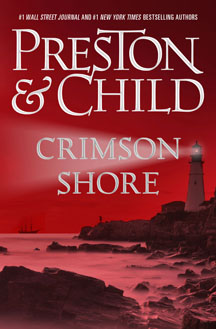“Crimson Shore” (November 2015 hardcover; now in paperback) is in many ways a classic standalone Douglas Preston and Lincoln Child potboiler, but it also has character, plot and thematic elements that push the Agent Pendergast series forward. The first thing readers will notice when delving into this 15th Pendergast novel is the sense of place, which isn’t unusual, although this particular location is.
Although the authors have thoroughly explored New York City, and have ducked into Maine (Preston’s “Impact”) and Rhode Island (Child’s “The Forgotten Room”) for solo works, “Crimson Shore” is the first of their catalog set in Preston’s home state of Massachusetts. The authors invent the town of Exmouth, on the northeastern coast – and it will eventually become clear why they were hesitant to set these events in a real town.
But the salt marshes, mud flats and lighthouses are real enough, as the authors do their thing of exploring a place on the globe that feels primitive and frightening even in this globalized age. I found the sequences of Pendergast and other investigators navigating the marshes – which range from wadeable to deadly depending on the level of the tides – to be a particularly fresh geographic challenge. This is one of those settings where you think: “I wouldn’t want to live there – or even necessarily visit – but I love visiting it in a book.”
The mystery starts intriguingly enough with the theft of a prized wine collection from the cellar of Percival Lake, a stone sculptor who lives in the old lighthouse keeper’s residence. Needless to say, the mystery soon thickens beyond the stolen wine. It ends up dating into centuries past and involving a British ship lost at sea, Salem witches and demonic lore.
Along with “Crimson Shore’s” delicious sense of place, Pendergast is in comfortingly fine form. He plays the lazy and corrupt Exmouth police chief like a fiddle, shows the chef at the local restaurant how to properly prepare fish, and pontificates on wine for enough pages that I briefly wondered if I picked up “Sideways” by accident.
His ageless ward, Constance Greene, is not merely along for the ride, but – building on the active heroism she displayed at the end of “Blue Labyrinth” — she continues to develop. She’s the audience surrogate who observes Pendergast entertainingly being Pendergast, but she is also learning tricks of the trade. In “Crimson Shore,” Constance – who is still an old soul learning about the modern world – realizes that claiming she is Amish works to brush away the curiosity of people she meets. Also, she realizes that simply pretending to showing interest in someone – particularly young males – makes them more willing to share information.
Two elements of “Crimson Shore” will be controversial to some readers. First, the authors hint at a romantic relationship between Pendergast and Constance. Like the old Mulder-Scully debate, some people will reject it out of hand because they like their guardian/ward relationship just fine, thank you. I’m willing to be open minded; the awkwardness of the post-wine-drinking scene in the hotel room is properly pitched. And recall that Constance did have a romance with Aloysius’ evil brother Diogenes, so surely she deserves a good man instead. Also, while she’s physically in her 20s, she’s actually over a century old, so the standard societal rules might not apply.

Secondly, “Crimson Shore” very nearly has supernatural elements. The main mystery wraps up about two-thirds of the way through this 337-pager, and then we get an extra layer to the story that Pendergast had overlooked. The monstrous antagonist, whose savagery leads to the type of “grotesque tableaus” we’ve come to expect from P&C’s horror writing, has similarities to those in “Relic” and “Still Life With Crows” – horrific, but with an element of humanity that gives us pause. I admire the way the authors tiptoe into the supernatural yet provide a barely plausible scientific explanation for how a human being could have a dog face and a tail.
An even more supernatural element comes when Pendergast essentially flow-walks (to borrow a “Star Wars” EU term) back in time to figure out the shipwreck mystery. I feel like he did this in at least one previous book. Again, this is barely plausible, asking us to pause before we label it “supernatural fiction” rather than “science fiction.”
Just as the third act adds a layer beyond what we saw in the first two acts, the final pages of “Crimson Shore” suggest there is even more going on. But that’s deferred until the 16th Pendergast novel, “The Obsidian Chamber,” which came out in October 2016.

